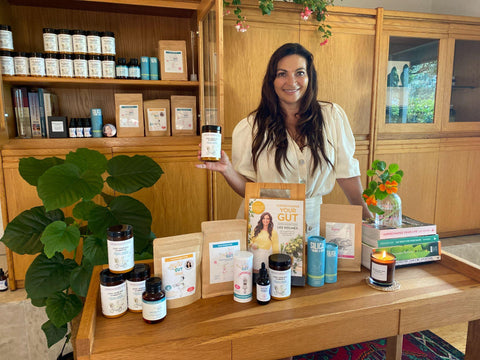April 06, 2022

This week we are sharing a great little New York Times article on bloating (which is also the source for the funny little headline - “What floats your bloat?”). It explores some of the factors contributing to bloating, you may have experienced one or more of these in your own daily life. Next up, we’re outlining some key dietary ways to help you mitigate these annoying symptoms.
First, take a couple of minutes to read the article. Don’t worry, we’ll be right here when you’ve finished to share foodie ideas to let the air out of the tyre around your belly (so to speak).
You’re back! A good read, huh?!?
We’re particularly interested in the body mechanics factors. It’s not always excess gas but the inner workings of the body starting with the diaphragm. Fascinating.

And 1 in 5 people have bloating! A pretty shocking statistic but no surprise to Supercharged Food founder and Clinical Nutritionist, Lee Holmes.
She says “I see many people in my clinic with what the article describes as ‘functional bloating’, that means bloating with unidentified causes. Sometimes we look at different diets and techniques to see what is most effective for the individual. In every case of functional bloating, in fact, any bloating, it’s most often a very tailored approach that works. In other words, “What floats your bloat”. We are getting outstanding results for people who have suffered with bloating for years and now see their symptoms disappear with changes to diet and natural supplementation such as my Love Your Gut Synbiotic”.
Foods That Gloat About Beating The Bloat

GINGER
Ginger in any from-fresh form. Have a knob of ginger in your kitchen at all times. Pop a slice into a cup, pour over and make it into a tea. You could also try our Love Your Gut Golden Gut blend which is a good source of ginger (it also tastes lovely).
PEPPERMINT TEA
To get your digestive system back on track, try drinking Peppermint Tea. If you’re in summer mode right now, make a large iced jug to keep in the fridge over the hot summer months. If you're feeling the chill, drink warming peppermint tea, it calms abdominal pain and helps food move through the intestines quicker too.
PROBIOTIC RICH FOODS
To balance good bacteria in your gut add probiotic rich foods to your daily diet. You can do this quite simply by including yoghurt at breakfast, over a bowl of fruit, muesli, or make a delicious smoothie in the blender with your choice of full fat no sugar added yoghurt. Probiotics help bring some balance back to your digestive system after all the excesses. Some foods to try are Jerusalem artichoke, chicory root, garlic, leek, onions, sauerkraut, asparagus, banana, oats, apples and barley. Taking a good quality probiotic will also help to maintain the numbers of good bacteria in the bowel.
HIGH FIBRE FOODS
Regularly have high fibre foods to keep you regular: avocado, green peas, spinach, kale and parsnips. There are loads more and endless ways to eat them. Avocado and spinach in smoothies, roasting vegetables like parsnips and carrots (yum!), get nostalgic for 2015 and have a kale salad!
Insoluble fibre, is fibre that doesn’t take on water as it passes through the digestive system and doesn’t break down, can help move along the built-up waste in the intestine. It has the added benefit of relieving constipation and preventing its return.
Here’s a short list of healthy, natural sources of insoluble fibre. Add these to your meals, wherever you can in the days leading up to big food events.
Our Love Your Gut powder and capsules aren’t actually sources of fibre but act like fibre in your digestive system. They help to create a good gut environment so it more effectively removes the buildup of waste and bacteria which cause bloating. It’s not a quick fix (avoid any ‘quick fix’) but over time and done consistently it works and it is super gentle on the body..
For more ways to ease digestion, read our article on taking care of the bloat here.
YOGA MOVES

Cat Cow is a must-do for bloating. Have you ever heard a cat or a cow complaining of bloating?!?
There are a number of simple, do (almost) anywhere yoga poses that can address the body mechanics aspect of bloating. Consider them as an internal massage to adjust your organs and activate your digestive system, in particular your colon.
Read more about the best 12 yoga poses for better digestion here.

The Recipe To Beat The Bloat
Asparagus is anti-bloating. It helps your body to flush excess water, relieving discomfort and bloat. Asparagus is a source of prebiotics, which help to support the growth of “good” bacteria in the gut.

Salmon Asparagus and Mushroom Frittata
SERVES 4
Method:
Comments will be approved before showing up.
April 16, 2025
"I always tell my clients: it's not about restriction, it's about addition. Add in gut-loving foods and fresh water alongside your Easter treats, and your body will thank you." - Lee Holmes
March 19, 2025
The Gut-Smart Way to Health: Why Investing in Your Gut is the Best Value for Your Wellness Dollar 💰🔍 Read on!